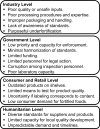Regulatory Monitoring of Fortified Foods: Identifying Barriers and Good Practices
- PMID: 26374804
- PMCID: PMC4570017
- DOI: 10.9745/GHSP-D-15-00171
Regulatory Monitoring of Fortified Foods: Identifying Barriers and Good Practices
Abstract
While fortification of staple foods and condiments has gained enormous global traction, poor performance persists throughout many aspects of implementation, most notably around the critical element of regulatory monitoring, which is essential for ensuring foods meet national fortification standards. Where coverage of fortified foods is high, limited nutritional impact of fortification programs largely exists due to regulatory monitoring that insufficiently identifies and holds producers accountable for underfortified products. Based on quality assurance data from 20 national fortification programs in 12 countries, we estimate that less than half of the samples are adequately fortified against relevant national standards. In this paper, we outline key findings from a literature review, key informant interviews with 11 fortification experts, and semi-quantitative surveys with 39 individuals from regulatory agencies and the food fortification industry in 17 countries on the perceived effectiveness of regulatory monitoring systems and barriers to compliance against national fortification standards. Findings highlight that regulatory agencies and industry disagree on the value that enforcement mechanisms have in ensuring compliance against standards. Perceived political risk of enforcement and poorly resourced inspectorate capacity appear to adversely reinforce each other within an environment of unclear legislation to create a major hurdle for improving overall compliance of fortification programs against national standards. Budget constraints affect the ability of regulatory agencies to create a well-trained inspector cadre and improve the detection and enforcement of non-compliant and underfortified products. Recommendations to improve fortification compliance include improving technical capacity; ensuring sustained leadership, accountability, and funding in both the private and the public sectors; and removing political barriers to ensure consistent detection of underfortified products and enforcement of applicable fortification standards. Only by taking concrete steps to improve the entire regulatory system that is built on a cooperative working relationship between regulatory agencies and food producers will a nutrition strategy that uses fortification see its intended health effects.
© Luthringer et al.
Figures






Similar articles
-
Regulatory monitoring systems of fortified salt and wheat flour in selected ASEAN countries.Food Nutr Bull. 2013 Jun;34(2 Suppl):S102-11. doi: 10.1177/15648265130342S112. Food Nutr Bull. 2013. PMID: 24050001 Review.
-
Regulatory and Policy-Related Aspects of Calcium Fortification of Foods. Implications for Implementing National Strategies of Calcium Fortification.Nutrients. 2020 Apr 8;12(4):1022. doi: 10.3390/nu12041022. Nutrients. 2020. PMID: 32276435 Free PMC article. Review.
-
The global regulatory landscape regarding micronutrient fortification of condiments and seasonings.Ann N Y Acad Sci. 2015 Nov;1357:1-7. doi: 10.1111/nyas.12854. Epub 2015 Aug 6. Ann N Y Acad Sci. 2015. PMID: 26251126 Review.
-
Implementing large-scale food fortification in Ghana: lessons learned.Food Nutr Bull. 2012 Dec;33(4 Suppl):S293-300. doi: 10.1177/15648265120334S305. Food Nutr Bull. 2012. PMID: 23444710
-
Large-Scale Food Fortification and Biofortification in Low- and Middle-Income Countries: A Review of Programs, Trends, Challenges, and Evidence Gaps.Food Nutr Bull. 2018 Jun;39(2):315-331. doi: 10.1177/0379572118774229. Food Nutr Bull. 2018. PMID: 29793357 Free PMC article. Review.
Cited by
-
The Policy of Compulsory Large-Scale Food Fortification in Sub-Saharan Africa.Foods. 2024 Aug 1;13(15):2438. doi: 10.3390/foods13152438. Foods. 2024. PMID: 39123628 Free PMC article. Review.
-
In-Country Method Validation of a Paper-Based, Smartphone-Assisted Iron Sensor for Corn Flour Fortification Programs.Foods. 2022 Jan 20;11(3):276. doi: 10.3390/foods11030276. Foods. 2022. PMID: 35159428 Free PMC article.
-
Food-based strategies for prevention of vitamin D deficiency as informed by vitamin D dietary guidelines, and consideration of minimal-risk UVB radiation exposure in future guidelines.Photochem Photobiol Sci. 2020 Jun;19(6):800-809. doi: 10.1039/c9pp00462a. Epub 2020 Oct 27. Photochem Photobiol Sci. 2020. PMID: 33856673 Free PMC article. Review.
-
Understanding drivers of private-sector compliance to large-scale food fortification: A case study on edible oil value chains in Bangladesh.Food Policy. 2021 Oct;104:102127. doi: 10.1016/j.foodpol.2021.102127. Food Policy. 2021. PMID: 34720342 Free PMC article.
-
Iodine Intake through Processed Food: Case Studies from Egypt, Indonesia, the Philippines, the Russian Federation and Ukraine, 2010-2015.Nutrients. 2017 Jul 26;9(8):797. doi: 10.3390/nu9080797. Nutrients. 2017. PMID: 28933750 Free PMC article.
References
-
- Hoddinott J, Rosegrant M, Torero M. Hunger and malnutrition. Lomborg B, editor Global problems, smart solutions: costs and benefits. New York: Cambridge University Press and Copenhagen Consensus Center; 2013. p. 332–367.
-
- Horton S. The economics of food fortification. J Nutr. 2006;136(4):1068–1071. - PubMed
-
- Baltussen R, Knai C, Sharan M. Iron fortification and iron supplementation are cost-effective interventions to reduce iron deficiency in four subregions of the world. J Nutr. 2004;134(10): 2678–2684. - PubMed
Publication types
MeSH terms
LinkOut - more resources
Full Text Sources
